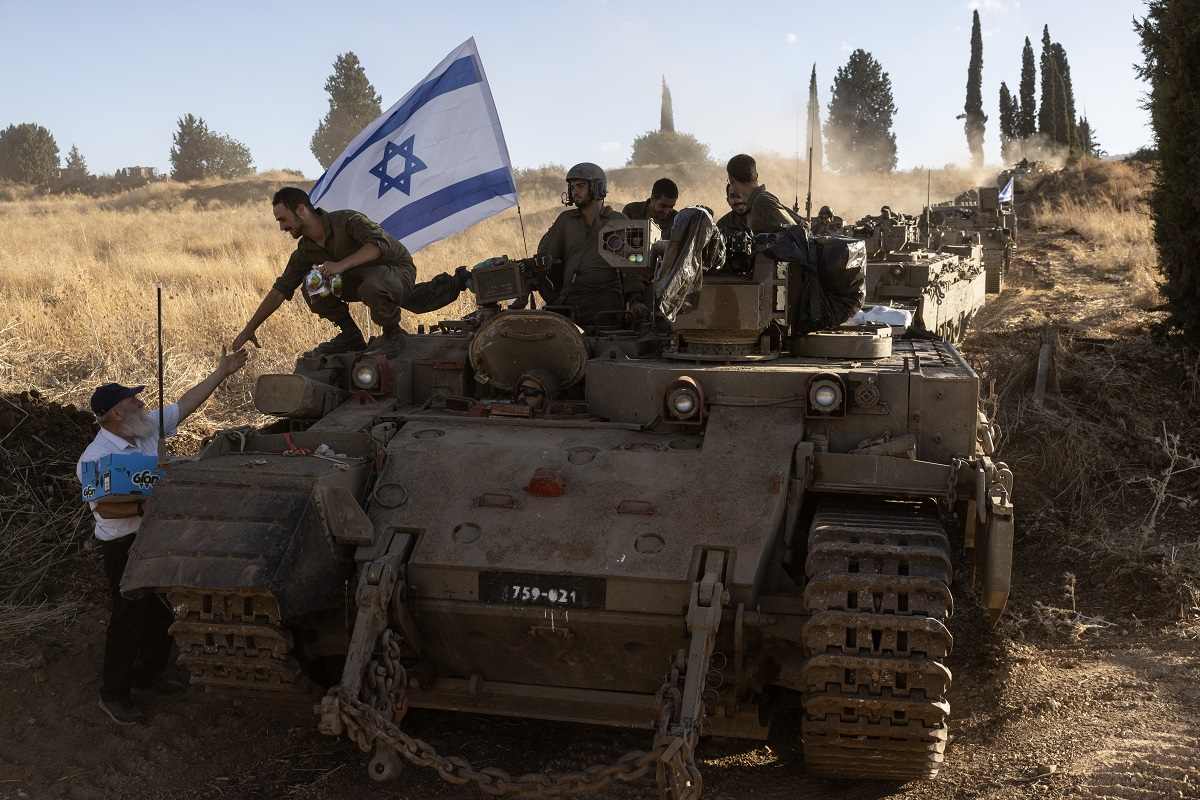
A convoy of Israeli tanks heads to the Lebanon border on Tuesday, As each tank rolled by, Gershon Fried, 72, of Safed, Israel, handed soldiers small bags of apples and honey, the traditional treat of the Rosh Hashanah holiday that started Wednesday night.
13:30 JST, October 3, 2024
TEL AVIV – Eight Israeli soldiers were killed in Lebanon on Wednesday in the first fatalities of Israel’s ground campaign against Hezbollah, a signal of the potentially bloody toll such an offensive could take as the military widens its battle with the militant group.
The Israel Defense Forces said the soldiers were killed in three separate incidents, with seven others seriously injured, but did not give further details. The statement came just hours after the military said it was engaged in “close-range” firefights inside Lebanese territory.
If the pace of Israeli casualties continues in Lebanon, experts say, it could shape the depth and scope of the offensive, which the IDF announced early Tuesday, saying the aim was to destroy Hezbollah infrastructure near the border. For Israel, the deaths will revive difficult memories of the invasion of Lebanon in 2006, when the first tank to cross the border hit a roadside bomb and four soldiers were killed.
“What will be the depth of the invasion? How much will be cleared? We don’t know,” said Yaakov Amidror, a former major general and Israeli national security adviser. “It will be decided depending on the achievements on the ground.”
The IDF has described the ground operations in Lebanon so far as “limited, localized and targeted” raids within a few miles of the border. But the large amount of tanks and thousands of troops now amassed in the north point to planning for a much larger foray than the one Israel has telegraphed.
Israeli Prime Minister Benjamin Netanyahu has given little away in terms of plans, other than vowing to keep striking Hezbollah with “full force” until it is possible for the more than 60,000 residents displaced along Israel’s northern border to return home. Hezbollah began firing rockets into northern Israel last Oct. 8, a day after the Hamas-led attack in southern Israel that killed about 1,200 people and saw more than 250 taken hostage.
Since then, Israel has embarked on a sweeping push against Iran-backed proxies on its borders and beyond, in an effort to restore deterrence, shift regional power dynamics and prevent further attacks.
But as Netanyahu weighs future moves, he will need to navigate domestic calls for decisive military action in Lebanon, while also addressing concerns that troops could get bogged down in skirmishes with fighters, and struggle to achieve the offensive’s bigger aims.
Far-right hawks, including in the government, have called for a more permanent “buffer zone” to be established on Lebanese territory. At the same time, the United States and other allies have tried to deter Israel from a large-scale war, amid fears of regional spillover and a worsening humanitarian crisis. In Lebanon, the Israeli military has already carried out more than 3,600 airstrikes and displaced as many as 1 million people, according to Lebanese Prime Minister Najib Mikati.
Limited border operations
Israeli military officials have said their key objective is to prevent Hezbollah from carrying out an Oct. 7-style attack in northern Israel, something the group has openly threatened for a decade.
It is unclear whether the group had imminent plans to launch an assault, but its fighters have spent years building military infrastructure, including attack tunnels, along Lebanon’s border with Israel.
The IDF assessed that Hezbollah had 2,000 to 3,000 elite Hezbollah fighters, known as the Radwan Force, operating roughly two miles from the border. An additional 6,000 to 8,000 militants were stationed six miles from the frontier, according to an Israeli military official who spoke on the condition of anonymity, in line with IDF protocol.
Israeli forces would need “a few weeks” to destroy infrastructure in the area, the official said.
Some of Hezbollah’s attack tunnels and materiel were already dismantled, according to the military, which said Tuesday that Israeli commandos had staged more than 70 raids in Lebanon in recent months, with some forces staying for several nights undetected.
But the ground forces going in now are part of “a different phase” and could do more “damage” to the group, the official said.
According to Miri Eisin, a former senior intelligence officer in the Israeli military who has been briefed on security deliberations, the military is aware it could get stuck battling militants in southern Lebanon, “where Hezbollah are the locals, they know where their booby traps are, where they can hide.”
As the operation moves forward, she said, the military will probably pivot to fighting at night, when it has the most advantage. And unlike in Gaza, where the IDF was tasked with eliminating Hamas as both a government and military force, in Lebanon it has more clearly defined tasks and goals by which it can measure progress, Eisin said.
A deeper push
“We’re not going to Beirut. We’re not going to the cities in southern Lebanon,” Israeli military spokesman Daniel Hagari said in a briefing Tuesday when asked by The Washington Post about the operation’s scope.
Over the past year, Israel has been clear that it expects Hezbollah to pull back behind Lebanon’s Litani River, which is about 18 miles north of the border and lies at the northern edge of what is supposed to be a U.N.-monitored demilitarized zone in southern Lebanon. Those boundaries were drawn up in a U.N. Security Council resolution at the end of the 2006 war.
And while the military has insisted it won’t stage a full-scale invasion, it has also ordered residents of 30 villages in southern Lebanon to move even farther north. In orders posted to X on Tuesday, the Israeli military said people should move above the Awwali River, more than 30 miles from the demarcation line.
Then, on Wednesday, the IDF announced that infantry and armored units were joining the fight, indications the military is preparing for a much larger ground campaign.
“The IDF and Israeli political echelons do not want to get stuck in a protracted operation that could boost Hezbollah, after it suffered several significant blows,” said Michael Horowitz, head of intelligence at Le Beck risk consultancy. “But that’s easier said than done.”
While the military may want to focus on the “first-line” villages located within six miles of the border, Horowitz said, there is always a risk the fighting could spread. “What happens if the IDF troops get fired upon from positions north of that, for instance?”
There is historical precedent for mission creep in southern Lebanon. The first time Israel invaded, in 1978, in a bid to destroy bases set up by Palestinian militants, it initially sought to occupy six miles of territory, according to the IDF. But three days in, the military decided to advance as far as the Litani River. Troops did not leave for another 22 years.
Buffer zone
But how will Israel hold on to any gains against Hezbollah? A “buffer zone” inside the border would leave its troops vulnerable, and be a “gift” to the militant group, Horowitz said. But as time goes on, there will be more pressure inside Israel to establish one, he added.
The calls for a buffer zone are already coming from Israel’s far right.
“A renewed buffer zone, free of enemy population, is the order of the hour and it is the right and most just thing to do both from a security point of view, both from a political and moral point of view,” Israel’s far-right Minister of Diaspora Affairs Amichai Chikli posted on X late last month. He attached several maps showing what he described as a “renewed border” slicing into Lebanese territory.
Last week, Itamar Ben Gvir, Israel’s far-right national security minister, threatened to withdraw from the government if Netanyahu agreed to a cease-fire in Lebanon, repeating a threat he has made regarding negotiations with Hamas.
Eyal Zisser, a Middle East expert at Tel Aviv University, said many Israelis doubt the operation will compel Hezbollah to agree to Israel’s terms: Halt fire into northern Israel and recommit to the 2006 agreement that required them to retreat.
“We have got to this certain point, but after a few weeks of raids, then what?” Zisser said.
Israel is no stranger to occupying ground in Lebanon. In 1982, Israel launched a second invasion of Lebanon that reached the capital, Beirut, withdrawing three years later to a broader “security zone” along the border that ranged from three to 12 miles and covered about 10 percent of Lebanon’s territory.
But not everyone believes Israel needs to occupy the buffer zone to maintain it. The zone could instead be enforced by a “very strict Israeli policy” that targets anyone who enters the designated area, said Ephraim Sneh, a former Israeli defense minister and commander of Israeli forces in the “security zone” in southern Lebanon in the early 1980s.
Ideally, an effective Lebanese or international force would be deployed on the ground to keep Hezbollah from rebuilding its military capabilities, Sneh said.
Still, as long as Israel pursues military options with no political or diplomatic tracks in place, it risks getting pulled into to a longer campaign, Horowitz said.
“Eventually, whatever Israel does militarily, a diplomatic resolution will be needed if Israel wants to avoid being stuck in Lebanon,” Horowitz said.
"News Services" POPULAR ARTICLE
-

American Playwright Jeremy O. Harris Arrested in Japan on Alleged Drug Smuggling
-

Japan’s Nikkei Stock Average as JGB Yields, Yen Rise on Rate-Hike Bets
-

Japan’s Nikkei Stock Average Licks Wounds after Selloff Sparked by BOJ Hike Bets (UPDATE 1)
-

Japanese Bond Yields Zoom, Stocks Slide as Rate Hike Looms
-

Japan’s Nikkei Stock Average Buoyed by Stable Yen; SoftBank’s Slide Caps Gains (UPDATE 1)
JN ACCESS RANKING
-

Keidanren Chairman Yoshinobu Tsutsui Visits Kashiwazaki-Kariwa Nuclear Power Plant; Inspects New Emergency Safety System
-

Imports of Rare Earths from China Facing Delays, May Be Caused by Deterioration of Japan-China Relations
-

University of Tokyo Professor Discusses Japanese Economic Security in Interview Ahead of Forum
-

Japan Pulls out of Vietnam Nuclear Project, Complicating Hanoi’s Power Plans
-

Govt Aims to Expand NISA Program Lineup, Abolish Age Restriction



















